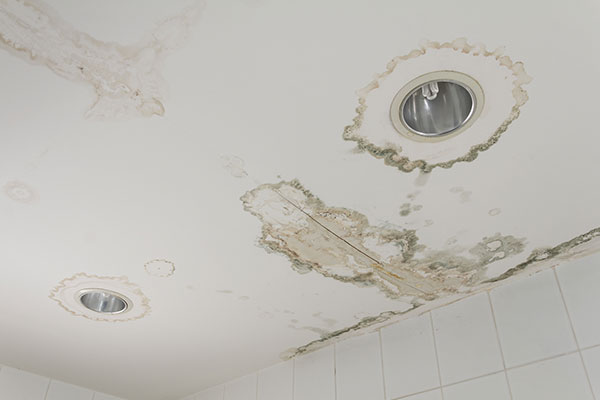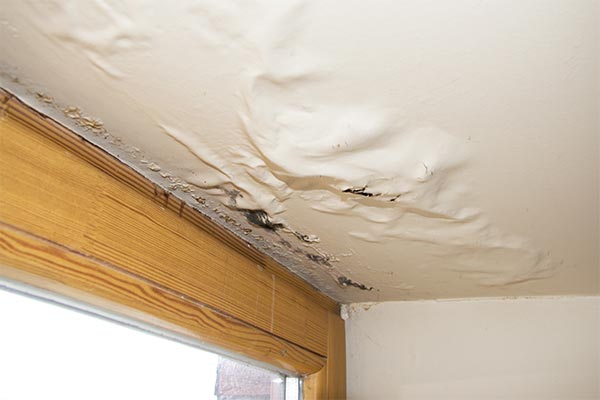In this comprehensive post, we'll go over;
The 5 Steps to take if you have ceiling water damage.
You'll also learn;
- The causes of ceiling water damage
- Signs of water damage
- What to do about water damaged ceilings
So if you've ever asked yourself any of these questions, you'll love this post!

Ceiling water damage can happen in a variety of ways, but what should you do? This guide lets you know what to do if your house has ceiling water damage, what causes it, and signs of water damage.
Each year, there are approximately 1 in 50 homeowners in the United States file a water damage claim, and many of these claims have to do with ceiling water damage.
Have you been part of this group? Are you dealing with ceiling water damage currently?
If your ceiling has been damaged by water, it's important to act quickly and address the problem as soon as you can. Read on to learn about the specific things you ought to do to correct this issue and restore your ceiling material.
What Causes Ceiling Water Damage?
There are a lot of ways that you can end up with water damage on your ceiling. The following are some of the most common causes of which you should be aware:
- Roof Damage from everyday wear and tear, as well as storms and severe weather. Ice damming can also be a culprit during the winter months.
- Water damaged area from a leak in your roof or your attic
- Leaky or burst pipes cause water dripping and damaged drywall
- Overflowing toilets or bathtubs
These are just some of the common causes of ceiling water damage. Keep in mind, though, that at the end of the day, any water source that leaks and finds its way down to your ceiling will result in the need for ceiling repair over time.
Signs of Water Damage on Your Ceiling

If your ceiling has water leaking through the drywall or plaster or has had a huge bubble form on it, it's pretty easy to tell that you're dealing with water damage. Sometimes, the signs are more subtle, though, and are easier to overlook.
Here are some other indicators of water damage:
- Yellow, brown, or copper spots or water-stained areas
- Ceilings are bubbling, cracking, or peeling
- Ceilings are sagging
- A piece of drywall is bulging
- Moldy, mildewy smell
Speaking of mold and mildew, you might also notice mold growth in the area where the water damage has occurred. This is a surefire sign that you're dealing with water buildup and damage. If the water damage and mold are left to spread, it is likely there will be further structural damage.
What to Do About Water Damaged Ceilings

If you’re all too familiar with any of the signs mentioned above, you're likely wondering what you should do about them. What is the best way to address a ceiling water damage issue? Especially when it comes to roof leaks and roof repairs?
By taking the following steps, you can minimize the amount of damage caused by the water, prevent health problems related to mold exposure, and make your home more resilient as you move forward:
- Prevent Future Damage
The first thing to do when you notice signs of water damage is to try and minimize the spread of the initial damage. At first, this might feel like an impossible task. Let's use the example of a leaking ceiling, though, to make it seem more manageable.
Let's say you find that your ceiling is leaking and water is getting all over your furniture. Before you do anything else, move the furniture out of the room so that it can start to dry and put down a bowl or bucket to catch the water.
- Identify the Source
Next, once you've stabilized the situation, you can start looking for the source of the water damage. Is it a leaking pipe? A leak in your roof?
You might not always be able to tell precisely where the water is coming from, but you should still do your best to track it down. Keep in mind, too, that water can travel very far from an initial leak. Because of this, you might have to do some digging to identify the original water source.
Depending on the source of the leak, once you find it, you might be able to at least temporarily stop it. For example, you could patch a hole in the roof to stop more water from coming in. Or if it’s accessible, you should turn off the water if it is caused by an overflow or a leaky pipe.
- Dry Out the Area
While you're working on identifying the source of and stopping the leak, you should also recruit others in your home to try and dry out the area. Laying down towels, opening up windows, pointing fans at the wet areas — all of this will help to prevent mold growth and minimize the damage caused by the water. For the best results, consider renting some high-volume fans and dehumidifiers and point the fans up toward the ceiling.
- Call in a Professional
In most cases, when you're dealing with water damage, it's best to call in an expert for backup. Reach out to a flood and water damage specialist who can help you get to the root of the issue, identify what, specifically, caused the problem, and help you come up with a plan to solve it.
Trying to handle water damage all on your own can be tricky, and you might even end up doing more harm than good if you're not careful. To avoid making potentially expensive mistakes, reach out to a professional as soon as possible.
- Repaint or Replaster
Once the water damage is fixed, your last job is to repaint or replaster the damaged parts of your ceiling. Sometimes, this is as simple as doing a bit of spot-spackling and painting. In other cases, though, you might need to replaster and repaint the whole ceiling.
Don't be afraid to contact a professional for help with this step, too. Again, if you don't know what you're doing, particularly when it comes to a full ceiling replastering or repainting project, you could accidentally cause more damage. The professional remediation team at Rock Emergency in Albany can handle both for you. Better yet, they will even work with your insurance company so you don’t have to!
It's always better to be safe than sorry, but this statement is even more true when you're dealing with something as important as your ceiling.
Take Care of Water Damage in Ceilings Today
If you're dealing with ceiling water damage, you need to act sooner rather than later. By addressing the issue right away, you can minimize the damage and avoid having to deal with more expensive repairs or replacements in the future. You can also take steps to protect your house from future water-related problems.
Do you need help fixing water damage on your ceiling? If so, reach out to our water damage restoration team for assistance. For those in the Albany, NY area, contact us today to learn more about our services or to schedule an appointment.
If you or someone you know is dealing with Ceiling Water Damage, call our Rock Emergency professionals at (585) 413-1566. Or click the button below to send us a message!
Share this Post
